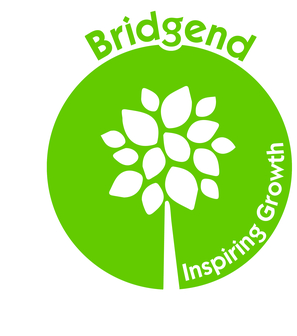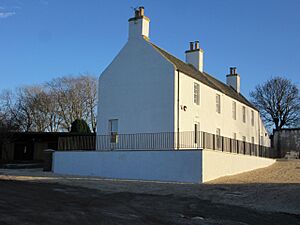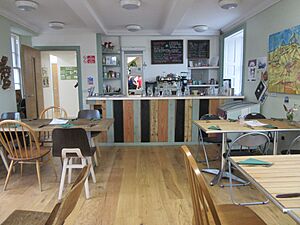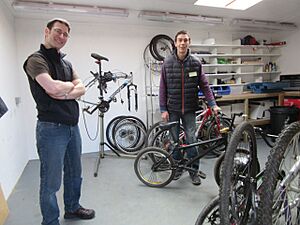Bridgend Farmhouse Community Project facts for kids
The Bridgend Farmhouse Community Project in Edinburgh, Scotland, is a special place run by the community. It's a charity that brought an old 18th-century farmhouse back to life. Now, it's a busy community hub with a café, garden, and workshops.
This project offers lots of classes, workshops, and training. You can learn different crafts and skills, no matter your age. It also has spaces for shows, meetings, talks, and fun events. The project is known as Bridgend Inspiring Growth (BIG). It was one of the first groups in Scotland to own a building in a city. In 2018, it changed its legal status to become a Community Benefit Society. This means the community truly owns and runs it.
Contents
History of the Farmhouse Site
The land where Bridgend Farmhouse stands has had buildings for a very long time. Some records show buildings here since the 1500s. It was once part of a royal hunting forest called Drumselch.
In the 1700s, a local minister wrote that King James V built a hunting lodge here. Next to it was a beautiful chapel. This chapel was likely built around 1518 by Sir Simon Preston. Later, in the 1800s, the chapel building was used as a stable. An archaeological study in 2014 confirmed that a large building stood on the chapel site long ago.
The current farmhouse building was built in the mid-1700s. It was made bigger in the early 1800s. At first, it was a farm that raised dairy cows and grew crops. Later, some of the land was sold to become a plant nursery. After the nursery closed in the 1960s, it went back to being a mixed farm. The Binnie and Darling families worked the farm for many years. The local council bought the land in 1998 and the house in 1965.
Between 2017 and 2019, a project called 'Place, Work, Folk' collected stories. It recorded memories from people who lived and worked at Bridgend Farmhouse. This helped to share the history of the place.
How the Project Started
The idea for the project began in 2010. A small group of local people wanted to save the old farmhouse. It was empty and falling apart. They held a meeting to discuss turning it into a community hub. They were inspired by Sir Patrick Geddes, a famous planner from Edinburgh. His idea was "work, place, folk."
In 2010, the group started the charity Bridgend Inspiring Growth (BIG). Their goal was to make the farmhouse and its land a community center. It would focus on nature and offer chances to learn and grow. For four years, they talked to people and planned events. They got advice on how to involve the community in designing the new center.
In 2014, the City of Edinburgh Council let BIG use the farmhouse for a year. Volunteers then started working every week to clean up the old site. The charity also received money from the council and other groups.
In 2015, the City of Edinburgh Council agreed to give the land and farmhouse to BIG for just £1. This was a big deal because it was one of the first times a city building was given to the community in Scotland. This happened before a special law about community ownership came into effect. The legal papers make sure the building will always be used as a community center for learning, eating, and exercise.
Later in 2015, the charity received a large grant of over £1 million. They also got more money from other trusts. Bridgend Farmhouse officially opened as a community center on March 24, 2018.
Bringing the Farmhouse Back to Life
The plan for restoring the farmhouse was created over many years. It involved talking to BIG members and the wider community. They held workshops and discussions to get everyone's ideas.
The goal was to fix the farmhouse carefully, keeping its old charm. They put back traditional features like the chimneys and windows. They also added four new workshops. These were built to look like old farm barns. The farmhouse itself kept its original structure. Many inside features, like wooden roof beams and the old staircase, were saved.
Malcolm Fraser was the main architect for the restoration. His team worked with other experts to design the project. A building company, Cornhill Building Services, did most of the construction. Volunteers from BIG also helped a lot. They worked on the workshops, painted, decorated, and built furniture. The restored farmhouse was ready in late 2017.
In January 2019, the project was praised for its architecture. It received a special mention for a RIBA MacEwan Award.
You can find more history about Bridgend Farmhouse online. There are also many interviews, recordings, photos, and stories from the 'Place, Work, Folk' project.
What the Project Aims to Do
The Bridgend Farmhouse project wants to create more chances for people. It helps people of all ages in nearby areas like Craigmillar, Niddrie, Inch, and Moredun. The project focuses on learning, healthy eating, and exercise.
Here are some of its main goals:
- Community Growth: Helping local communities develop. It aims to improve skills for being active citizens. It also provides chances for volunteers and offers training in outdoor skills. This helps people understand the environment better.
- Healthy Living: Encouraging healthier choices for both body and mind. It also helps reduce loneliness by offering a friendly place to meet people.
- Understanding History: Helping people learn about the history and heritage of the area.
- Fairness for Everyone: Making sure everyone has equal chances and promoting diversity.
- Caring for Nature: Encouraging people to use Craigmillar Castle Park more. It also teaches about different plants and animals and how to protect the environment.
What You Can Find There
Bridgend Farmhouse has many great facilities:
- An outdoor education workshop
- A bicycle workshop
- An arts and crafts workshop
- A DIY workshop
- A room for exhibitions and meetings
- An outdoor stage for performances
- A kitchen garden
- A mindfulness garden
- An eco-bothy (a small, eco-friendly shelter)
- An outdoor play area
- External barns
- A community café
- A training kitchen
Fun Activities and Projects
There are lots of activities and projects at Bridgend Farmhouse. The 'Place, Work, Folk' project collects local history. It includes recording stories from people who live nearby.
Every Wednesday and Sunday, there are open volunteer sessions. You can help with gardening, building, woodworking, landscaping, arts and crafts, cooking, and other group activities. The café kitchen offers training courses. You can even get qualifications in Food Hygiene and Health & Nutrition. There are also courses to help you get a Scottish Qualification Award in 'Working With Others'.
Another project is 'Real Fast Food'. This involves making healthy food from local ingredients. Volunteers then deliver it to people who can't leave their homes. They use an electric bike and trailer for deliveries. There have been courses in crafts like lime mortar pointing (a building skill) and gardening. Other courses have included "Making natural cosmetics," "Forest skills," and "Intergenerational storytelling," which created a book of shared stories.
Regular community groups meet here too. These include a weekly singing group, a craft club, and a woodwork club.
The project also has an 'Acorn Fund'. This fund helps local people and groups with their own projects at the site. Some past projects include "Building a wormery," "Wood carving," "A singing group," "A seed library," "Film & media training for volunteers," and "Medicinal dhal workshops."
Working with Others
Bridgend Inspiring Growth works with many other groups and organizations. These partnerships help the project do even more for the community.
Charitable Organisations
|
|
Schools
Universities and Colleges
|
Other Groups
|
How the Project is Run
In 2018, BIG became the first group in Scotland to change its legal structure. It became a Community Benefit Society with Charitable Status (CCBS). This means that people can buy shares to become part-owners of the land and project. Each member gets one vote, no matter how many shares they buy.
The first Community Share Issue in 2018 raised over £70,000. About 400 members bought shares. These members have a say in the future of the organization. They can vote at the Annual General Meeting (AGM) and help guide the project.
BIG has a board of twelve trustees, all of whom are volunteers. At least half of the trustees must live in the local area. This ensures that local voices are always heard in important decisions.
The organization has a democratic structure. This means volunteers and members can help decide how the project works. There are four working groups that meet every month: Buildings and Land, Activities and Events, Food, and Business. These groups are where volunteers work together and make decisions.
Awards and Special Recognition
Bridgend Farmhouse has received many awards and special mentions for its great work:
- In January 2019, it was praised for its architecture. It received a special commendation for a RIBA MacEwan Award. This award is for projects that do good for the community.
- The Scottish Government chose Bridgend Farmhouse as an example of good practice in 2018. This was for its strategy to help with social isolation and loneliness.
- In June 2019, the project received a 'Special Commendation' in the 'Celebrating Communities' category. This was at the Scottish Council for Voluntary Organisations (SCVO) Charity of the Year awards.
- In 2020, the project won the Scottish Design Awards national Regeneration Award. It also won the Edinburgh Architectural Association Wood Award and the Voluntary Arts Scotland Epic Award for the Bridgend Eco-Bothy.
- In 2021, they received the Queen's Award for Voluntary Service. They were also nominated for the Scottish Urban Regeneration Forum community-led regeneration award in 2020 and 2021.





